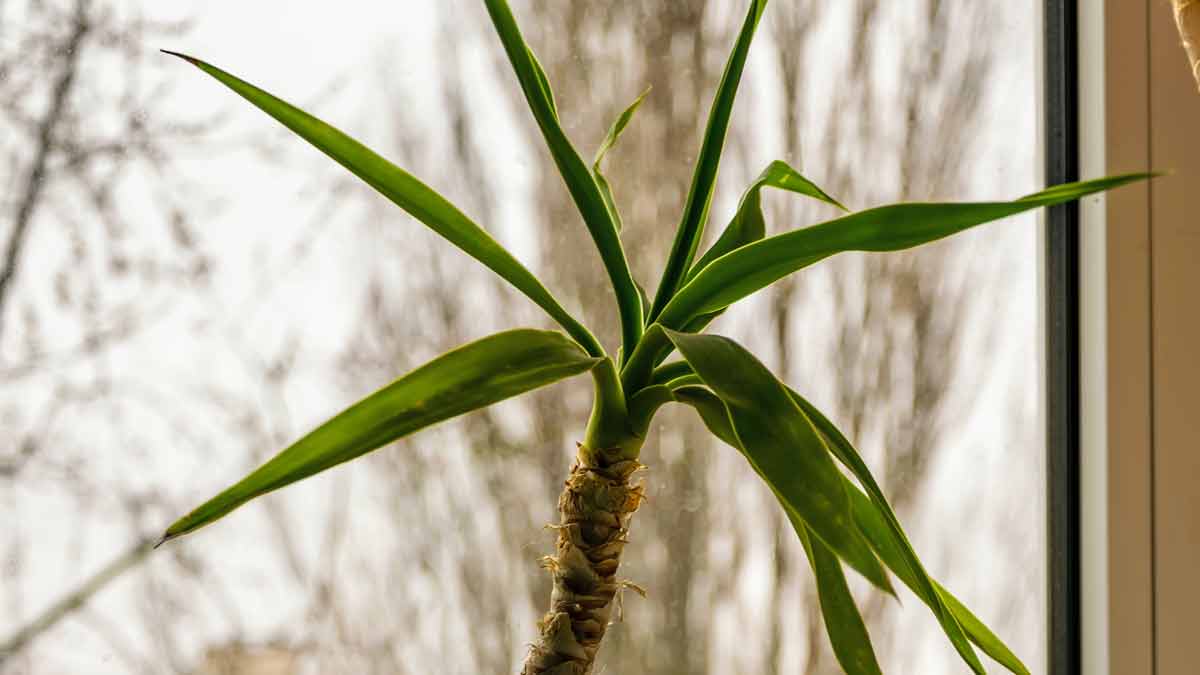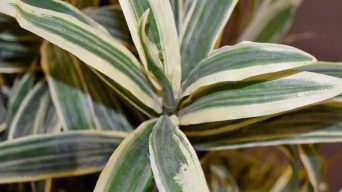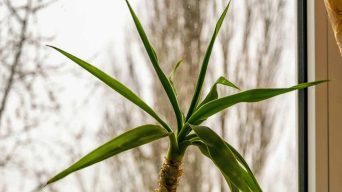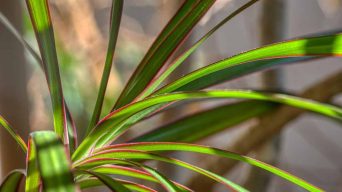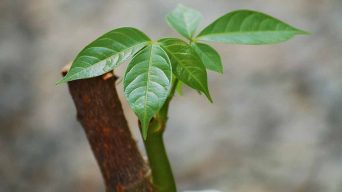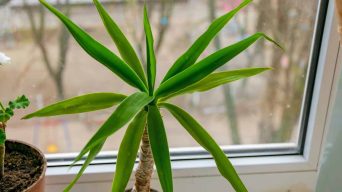The most common reason dragon tree leaves fall off is improper watering. Overwatering or underwatering dracaena plants can cause their leaves to turn yellow and eventually fall off. Other common causes include pest infestations, insufficient light, and lack of nutrients.
Dracaena, or dragon trees, have become increasingly popular houseplants due to their ease of care and variety of appealing leaf shapes, colors, and sizes.
Although these plants are usually undemanding in terms of upkeep, there may be instances when their leaves start to fall off.
To help prevent this from occurring, it is essential to understand why dragon tree leaves may be dropping and how to rectify the problem. This article will provide insight into both of these topics.
What Causes Dragon Tree Leaves to Fall Off?
To identify the precise source of trouble with your dragon tree, you must closely examine it.
Dropping leaves off a dracaena is frequent, and several possible causes must be considered.
1. Overwatering
When it comes to caring for dracaena plants, one of the most common mistakes owners make is overwatering.
Dragon trees, which are native to Africa, thrive in dry, sandy soil and can withstand drought-like conditions.
As a result, too much water can harm the plant and cause leaves to fall off.
It’s important to allow the soil of your dracaena plant to dry out between waterings so the roots don’t become overly saturated or start to rot.
To ensure you aren’t giving your dragon tree too much water, check the top inch of its soil before each watering session. If it feels dry, you can go ahead with your usual routine; but if it’s still damp or wet, hold off on giving your plant any more water until it has had a chance to adequately dry out.
2. Underwatering
Watering your dragon tree is essential, as it can be adversely affected by overwatering and underwatering.
Underwatered dracaena plants may suffer from wilting and yellowing of their leaves and leaf loss.
To avoid such problems, make sure you are watering your dracaena regularly and adequately.
Water them at least once a week during the growing summer season. However, it’s best to soak the soil until the water runs out of the drainage holes at the bottom of the pot.
If a plant appears to be wilted or has yellowing leaves, this may indicate that it needs more water than usual. In such cases, give an extra soak to ensure that all its needs are met
3. Temperature Stress
When caring for a dragon tree, it’s important to create the right environment to prevent leaves from falling off. This is especially true if temperature stress is an issue.
Dracaenas are tropical plants and require warm temperatures to remain healthy and vibrant.
Ideally, the temperature should stay above 60 degrees Fahrenheit at all times, as they can’t tolerate any cold drafts or cooler air.
If your dracaena is near a window or door where a draft could occur, move it away to a more protected area.
To make sure the temperature in your home remains at an ideal level, consider raising the thermostat or placing a space heater in the same room as your tree so you can monitor its effects and make adjustments as needed.
Temperature fluctuations can have a significant impact on your dracaena’s growth and health. Ensure that all changes are made carefully and with ample consideration of how they may affect your plant’s well-being.
4. Nutrient Deficiencies
To remain healthy and thrive, dragon trees require essential nutrients such as nitrogen, phosphorus, and potassium.
To ensure that your dragon tree receives the proper amount of these nutrients, fertilize it every two weeks during its growing season with a balanced fertilizer.
Failing to provide sufficient nutrients to the dracaena can result in the premature shedding of its leaves.
When applying the fertilizer, make sure you spread it evenly around the tree’s base and water it lightly afterward to help absorption.
Properly nourishing your dragon tree will allow it to live up to its full potential and reach its maximum height and width.
This will make for an attractive plant in any home or garden and ensure its vibrant coloration and lush foliage for years to come.
5. Too Much Sunlight
Dragon trees need bright indirect sunlight to thrive and grow healthily.
When too much sun is present, its leaves may start to turn yellow or brown due to scorching; this causes them to fall off.
To prevent this, it’s important to move the plant to a spot that receives indirect sunlight or make use of a sheer curtain as a filter for the light.
During the summer season, gradually place your dracaena outdoors to prevent their leaves from being burned by the intense sunlight.
To ensure healthy growth, exposing your dragon tree to sufficient amounts of bright but filtered sunlight is beneficial.
This may include areas that receive partial shade during parts of the day, and areas close enough to a window so natural light can still reach it.
When placing a dragon tree outdoors, ensure it is fully acclimated first before exposing it directly to the sun for longer periods since sudden exposure to intense light can cause damage.
6. Not Enough Light
Your dragon tree needs plenty of bright, indirect sunlight to thrive. Without it, its leaves can begin to yellow and drop off, and the plant may start stretching out.
To ensure your dracaena has enough light, move it to a spot that receives indirect sunlight for several hours daily.
If this isn’t possible, you could also consider using a grow light to supplement the existing morning sunlight it receives.
Grow lights can provide an artificial source of light that mimics natural daylight. They are particularly useful if your home doesn’t receive adequate natural lighting or if you want additional lighting during the winter months when the days are shorter.
For optimum results, place your grow light approximately 12 inches away from your dragon tree and keep it on for 12–16 hours a day. This will help ensure your plant stays healthy and strong so that its vibrant foliage can continue to bring life into any room.
7. Soil Issues
When caring for a dragon tree, it is important to ensure that the soil they are planted in is well-drained and high in organic matter.
To achieve this, gardeners should combine equal parts potting soil, perlite, and compost when repotting their dracaena.
Without these ideal conditions, the roots of the plant may not be able to access the oxygen they need to survive, leading to a decrease in health and potentially causing leaves to drop off.
8. Pest Infestation
Spider mites, mealybugs, and scale insects can cause severe damage to dragon trees by sucking the sap out of the leaves or stems, resulting in leaf loss.
To identify these pests, carefully observe the plant for signs such as webbing on the leaves for spider mites, white cottony masses for mealybugs, and small brown or black bumps on the stems and leaves for scale insects.
Getting rid of these pests can be done by washing them off with a steady stream of water or applying an insecticidal soap to eliminate them.
Additionally, it’s important to regularly check your dracaena plants since pests often spread quickly and can cause significant harm if left untreated.
It’s best to catch an infestation early before too much damage is done since that way, you can easily remove them before they cause serious harm to the plant.
If you already have a pest problem, you may need more drastic measures, such as insecticides or horticultural oils to resolve it. In any case, always make sure to follow instructions on labels when using any type of pesticide or chemical control method.
9. Diseases
Overwatering or planting your dragon tree in poorly drained soil can lead to root rot, a common disease that can cause dracaena leaves to fall off.
Root rot prevents the dracaena plant from accessing the water and nutrients it needs to survive, so it is important to ensure proper drainage of your dragon tree’s soil.
Similarly, leaf spot is a fungal or bacterial infection that manifests as small brown or black spots on the leaves; if left untreated, this infection can cause leaves to drop prematurely.
To prevent diseases and keep your dragon tree healthy, take care not to overwater the plant, and be sure it is planted in an area with good soil drainage.
10. Transplant Shock
Transplanting a dracaena can be an intense process for the plant, which may cause its leaves to fall off due to the amount of stress it goes through.
To help ensure your dragon tree adjusts successfully to its new home and minimizes transplant shock, it’s important to properly acclimate it before transplanting. T
his can involve gradually introducing it to different light levels and temperatures in its new environment and giving it enough time to adjust before transplanting.
11. Natural Leaf Drop
As a dragon tree ages, its leaves will naturally begin to yellow and drop off, clearing the way for new growth. It is common for the lower leaves of a tree to fall off more often than those near the top.
If only a few leaves are dropping at any given time, there is usually no need to worry.
However, if the plant is suddenly beginning to lose many of its leaves or they are turning brown or yellow, it could be symptomatic of other issues.
12. Improper Fertilization
Fertilizing your dragon tree is a must for its successful growth.
When done improperly, it can lead to the falling of leaves. For optimal growth during the growing season, fertilize with a balanced fertilizer every two weeks. During winter months, reduce the amount of fertilization to once a month.
With more frequent usage than recommended, the roots may be burned, and leaf loss may occur.
It is important to read and follow the directions on the label when using this fertilizer, as improper use may have serious consequences for your dragon tree’s health.
What To Do When Dracaena Leaves Fall Off
If your dragon tree is suffering from dropping leaves, there are several steps you can take to help the plant.
Check The Soil
The best way to ensure that your Dragon Tree remains healthy and vibrant is to check the soil drainage.
To do this, stick your finger into the soil and feel for moisture. If the soil feels soggy, it is likely that the drainage is too poor and needs to be improved with organic matter, such as compost.
Planting your dracaena in a pot with drainage holes will also help to ensure its well-being. Good drainage is essential, as standing water can cause root rot which leads to discoloration of leaves and potential loss of them.
Check The Watering Schedule
Watering your dragon tree correctly is key to keeping its leaves healthy and vibrant. This means not overwatering the plant, which can cause the leaves to drop off prematurely.
Keeping an eye on the top inch of soil is a good way to tell when it needs more moisture. You should water your dragon tree once a week in general, though during winter months, it might require less water.
Prune The Plant
To help your dragon tree thrive and promote new growth, pruning is recommended. Start by carefully inspecting the plant for any dead, dying, or diseased leaves and promptly remove them. With a pair of sharp shears, trim back the long, leggy stems to encourage a fuller shape. In addition, remove any yellow or brown leaves that have already begun to die off.
Move The Plant To A Bright Location
Positioning a dragon tree in an area of bright indirect light is essential for its health and well-being.
Optimal locations include east- or west-facing windows, which provide the perfect balance of illumination without it becoming too intense. If not receiving enough light, the plant’s leaves may wilt and drop off.
To ensure this doesn’t happen, move the dragon tree to an environment that is brighter and more suitable for it.
It’s important to remember that direct sunlight should be avoided, as this can lead to scorching of the leaves and damage the plant.
Adjust The Temperature
To ensure the health of dragon trees, temperatures between 65°F and 75°F (18°C and 24°C) should be maintained. This is because colder or hotter temperatures can cause the leaves to fall off.
To address this issue, it is important to regulate the climate in the room in which the plant resides. If it is too cold, a space heater may be used, while a fan or air conditioner can work well when the temperature gets too high.
Additionally, drafts coming from windows or doors should be avoided as these can also lead to leaf loss. Proper climate control is essential for healthy dragon trees and should not be neglected.
Check For Pests
Pests can be a major cause of dragon tree leaves falling off. Examples of these destructive pests include mealybugs, spider mites, and scale insects.
To detect the presence of pests, it is important to check the plant carefully for any small bugs or eggs. Additionally, one should look for damage signs, such as holes in leaves.
If any of these signs are found, the pests must be removed either by hand or with insecticide soap or neem oil. This will not only get rid of the pests but also prevent them from returning.
Check For Diseases
Dracaena, a tropical species of plant, often experiences leaf loss due to a variety of diseases.
One of the most common is root rot, which is caused by overwatering and an accumulation of water in the soil.
To determine if this has occurred, it’s important to inspect the plant’s roots closely; they may appear black or mushy if they have been affected.
To treat root rot, it is necessary to remove the affected roots and replant the dragon tree in soil that will allow excess water to drain away.
Fertilize The Plant
Fertilizing your dracaena regularly is essential to make sure its leaves keep growing healthy. During the growing season, you should apply a balanced fertilizer to your dragon tree every month.
Fertilizer helps replenish the plant’s nutrients to keep its leaves strong and vibrant. Using too much fertilizer, however, can have the opposite effect: too many nutrients may lead to leaf loss.
To avoid this, make sure you follow the instructions on the fertilizer package closely and reduce fertilizing frequency during winter months.
Replace The Soil
Using fresh soil is essential in replenishing nutrients that have been depleted over time.
Without these necessary nutrients, leaves may begin to drop off, so regular soil replacement is key to maintaining a healthy dragon tree.
Carefully remove the dragon tree from its existing pot and then replace the soil with a nutrient-rich potting mix. To further enhance drainage, consider incorporating some compost or other organic matter into the new soil.
Once you have re-potted the dracaena plant, wait a few days before watering it to ensure it has had time to settle in.
Keep an Eye on The Plant
Dragon trees require proper care and attention; otherwise, their leaves can start to fall off. This is a sign that something is wrong and should be addressed as soon as possible, so the plant can continue to thrive.
If the plant is healthy, it may shed some of its leaves as part of its normal growth cycle.
But if multiple leaves are turning yellow or brown or a large number are falling off all at once, this could indicate inadequate care or environmental conditions.
What Are The Benefits Of Dragon Tree Leaves Falling Off?
When a dragon tree undergoes the process of abscission, it can be a beneficial process.
Abscission is the natural method the plant uses to rid itself of old or damaged leaves while conserving water and energy during periods of drought or other environmental stresses.
By shedding these leaves, the dracaena can make room for the new ones to grow, thus leading to healthy and balanced growth.
The abscission process does not necessarily mean that something is wrong with your dragon tree. In fact, this is a perfectly normal part of its life cycle and should be expected from time to time.
It should also be noted that losing some older leaves can actually help promote healthier new growth in your dragon tree by freeing up more resources for nourishment and growth.
What To Do With Dracaena Leaves That Have Fallen Off?
Dragon tree owners can use the fallen leaves in their compost pile or even bury them in the soil around their trees.
The leaves are high in nitrogen which helps plants to grow, releasing their nutrients into the soil over time to promote healthy growth.
Mulching is also an effective way to protect dragon trees from the elements, insulating them and shielding their roots. To do this, spread a layer of leaves, bark, or straw around the base of the plant; this will help keep moisture in the soil and deter weed growth.
When used correctly, mulching can be a great way to ensure that your dragon tree remains healthy and thriving for many years
Final Thoughts
Dragon trees naturally shed their leaves as they grow, but if you notice an excessive amount of leaf loss or the leaves turning yellow or brown, it could be a sign that something is amiss.
Investigating and taking action is important to ensure your dragon tree regains its health.

